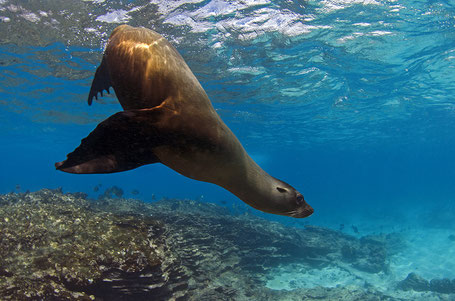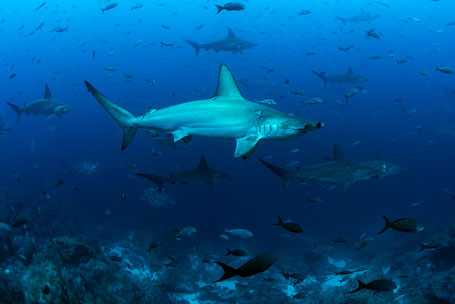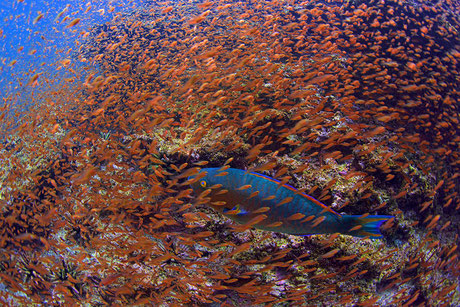15 day Galapagos Itinerary
Every week, every day dive and water conditions change in the Galapagos Islands. If you decide for the 15 day / 14 night liveaboard dive experience you will double your chance to see the wildlife you are coming for - hundreds of hammerhead sharks, whale sharks, marine iguanas, sunfish - and so much more!
Tuesday
Morning: Santa Cruz - Baltra Airport
Afternoon: Santa Cruz - Baltra Island (1 check dive)
Wednesday
Morning: Cape Marshall (2 dives)
Afternoon: City of Mantas (1 dive)
Thursday
Morning: Darwin's Arch (2 dives)
Afternoon: Darwin's Arch (2 dives)
Friday
Morning: Darwin's Arch (2 dives)
Afternoon: Wolf Island (2 dives)
Saturday
Morning: Wolf Island (2 dives)
Afternoon: Wolf Island (1 dive)
Sunday
Morning: Punta Vivente Roca (1 dive)
Afternoon: Cape Douglas (1 dive)
Monday
Morning: Cousin's Rock (2 dives)
Afternoon: Santa Cruz - Tortuga Bay
Tuesday
Morning: Santa Cruz - Baltra (optional land visit)
Afternoon: North Seymour (1 dive)
Wednesday
Morning: Cape Marshall (2 dives)
Afternoon: City of Mantas (1 dive)
Thursday
Morning: Darwin's Arch (2 dives)
Afternoon: Darwin's Arch (2 dives)
Friday
Morning: Darwin's Arch (2 dives)
Afternoon: Wolf Island (2 dives)
Saturday
Morning: Wolf Island (2 dives)
Afternoon: Wolf Island (1 dive)
Sunday
Morning: Punta Vivente Roca (1 dive)
Afternoon: Cape Douglas (1 dive)
Monday
Morning: Cousin's Rock (2 dives)
Afternoon: Santa Cruz - Highlands with Giant tortoises
Tuesday
Early Morning: Baltra Airport depart or continue with land extension

Day 1 - TUESDAY - BALTRA ISLAND -Arrival , transfer & Check Dive
AM - Baltra Island
Guests fly to the Galapagos Islands from mainland Ecuador, arriving in the late morning. The GWSP dive masters and yacht dive master/naturalist guide will be waiting at the airport on Baltra Island. Once the group has collected their luggage and cleared the National Park immigrations we will board the Yacht which will be anchored in the port 10 minutes travel by bus. After everyone has settled in their cabins the guides will give a briefing on ship life, national park rules and diving safety, whilst the galley crew prepare the dining room for a delicious buffet lunch.
PM - Baltra Island (Check dive, equipment and weights)
After a briefing on the dive platform all equipment should be set up in readiness for the test dive. This will be at a nearby anchorage in calm shallow waters. Maximum depth of 12m. Although plentiful fish and usually sea lions and other species are to be seen, the objective is to check weight and equipment for the following days.

Day 2 - WEDNESDAY: Cape Marshall / City of Mantas
AM & PM - Cape Marshall (2 - 3 Dives)
This area on the northeast side of Isabela island offers a few great dive spots. One of them is Cape Marshall, also called 'Ciudad de las Mantas' (City of Mantas),
named for how common it is to see giant mantas. The plankton-rich waters of this area are an attraction for many species of rays - like the eagle ray or giant manta, white tip sharks, sea lions,
green sea turtles and many more. The topography is beautiful and invites divers to enjoy their first dives in the Galapagos Islands.

Day 3 - Thursday: DARWIN's arch
AM & PM - Darwin Island (4 dives)
All four dives are at the same site, the world renowned Darwin Arch. We drop on to a rocky ledge and from a protected position watch the marine life swim by. Hammerhead and Galapagos sharks, Black tips and Silkies. Marine turtles abound and Bottlenose dolphins often pass by overhead. Huge schools of fish, tuna, jacks and Creole fish swim in the blue whilst dozens of other species inhabit the coral covered platform and ledges.

Day 4 - Friday: Darwin's arch & WOLF ISLAND
AM - Darwin's Arch (2 dives)
This is also the realm of the biggest shark of them all, the Whale shark. Frequenting the Islands between June – December over 95% of all sightings occur here at the Arch. Of these a staggering 99% are female and in an apparent state of advanced pregnancy. Why they come to this rocky volcanic outcrop remains a mystery and one that the Galapagos Whale Shark Project team is trying to solve.

PM - Wolf Island (2 dives)
The powerful marine currents around Wolf are part of the reason we see so many sharks. Schooling hammerheads, Galapagos sharks, Black tip and Silky sharks are the usual protagonists. Dolphins are often present as we end our dives with a drift in the blue. Two turtle species, the Green and Hawksbill are frequently sighted along the rocky walls and slopes of this island. Eagle rays and large schools of fish, snappers, grouper and jacks patrol the drop-off.
Depending on the conditions we will offer a night dive in Wolf Island.
The island is home to vast numbers of sea birds, Red footed and Nazca Boobies, frigate birds, the endemic Swallow – tailed gull and the elegant Red – billed tropicbird. Finches and doves are often spotted hoping amongst the rocks.

Day 5 - SATURDAY: WOLF ISLAND
AM & PM - Wolf Island (3 dives)
Another full day exploring the diverse dive sites of Wolf. The dives may take us to the swim through arches and along the spectacular walls and cave entrances. Again the local conditions will decide which are the best options dependent on current and swell. More time to observe the sharks and marine megafauna or study the massive diversity of life that inhabits the large coral heads and boulder slopes. Towards evening we set sail for the north of Isabela Island.

Day 6 - SUNDAY: Punta Vivente Roca / Cape Douglas
AM - Punta Vicente Roca (1 dive)
This morning we will dive at Punta Vicente Roca. Best known for the frequent sightings of Mola alexandrini, the southern ocean sunfish. The Molas approach the wall to visit the cleaning stations where wrasses and angelfish await. Sea lions and Galapagos fur seals abound and often follow divers playing with bubbles and darting in and out of schools of sardine sized Brown striped Salemas. The wall is one of the most diverse of all Galapagos for marine invertebrates and is one of the favourite sites for macro photography. Brightly coloured blennies, Long nose coral hawkfish, frogfish and sea horses can be found amongst the solitary corals, anemones, tunicates and sponges. Green sea turtles are present all year and whales are often spotted in these waters.

PM - Cape Douglas (1 dive)
After sailing across the Bolivar channel to Fernandina Island we will dive at Cape Douglas. Showcased by many documentaries including BBC’s Blue Planet I & II, this is where marine iguanas are to be found feeding in the shallow bays between 5-10m. A unique experience that can only be had in the Galapagos we also find the endemic flightless cormorant and Galapagos penguins feeding here. The cold ocean upwelling from the Cromwell current brings a myriad of life to an apparently stark volcanic shore.

Day 7 - Monday - Cousin's ROck / santa Cruz
AM - Cousin's Rock (2 Dives)
In Cousin's Rock we often find playful sea lions, Eagle rays, Golden rays and sometimes Mobula and Giant Pacific manta rays. The underwater topography provides refuge for sleeping turtles and white tip sharks whilst the steep walls are covered by marine invertebrates. Two species of black coral, sponges and colonial tunicates are a colourful backdrop for the abundant fish that frequent this emergent volcanic cone. The currents often found here attract some of the larger shark species such as hammerheads and black tip sharks. Amongst the corals we sometimes find Pacific golden sea horses and frogfish.

PM - Santa Cruz Tortuga Bay (land excursion)
After the dive we will go to Santa Cruz Island. Take your swimming suit with you - we are going to Tortuga Bay - one of the most beautiful beaches in Galapagos! If you feel more like souvenir shopping - no problem at all. Puerto Ayora is a nice little town to walk around.

Day 8 - TUESDAY: NORTH SEYMOUR
AM - Santa Cruz
Morning to organise photos, do some yoga on the sundeck (guided if requested), read and relax.
PM - Baltra/North Seymour
Depending on the weather conditions we will explore the channel between Baltra Island and North Seymour. You can find plentiful fish and usually sea lions and other species are to be seen.

Day 9 - WEDNESDAY: Cape Marshall / City of Mantas
AM & PM - Cape Marshall (2 - 3 Dives)
This area on the northeast side of Isabela island offers a few great dive spots. One of them is Cape Marshall, also called 'Ciudad de las Mantas' (City of Mantas), named for how common it is to see giant mantas. The plankton-rich waters of this area are an attraction for many species of rays - like the eagle ray or giant manta, white tip sharks, sea lions, green sea turtles and many more. The topography is beautiful and invites divers to enjoy their first dives in the Galapagos Islands.

Day 10 - Thursday: DARWIN's Arch
AM & PM - Darwin Island (4 dives)
All four dives are at the same site, the world renowned Darwin Arch. We drop on to a rocky ledge and from a protected position watch the marine life swim by. Hammerhead and Galapagos sharks, Black tips and Silkies. Marine turtles abound and Bottlenose dolphins often pass by overhead. Huge schools of fish, tuna, jacks and Creole fish swim in the blue whilst dozens of other species inhabit the coral covered platform and ledges.

Day 11 - Friday: Darwin's Arch & WOLF ISLAND
AM - Darwin's Arch (2 dives)
This is also the realm of the biggest shark of them all, the Whale shark. Frequenting the Islands between June – December over 95% of all sightings occur here at the Arch. Of these a staggering 99% are female and in an apparent state of advanced pregnancy. Why they come to this rocky volcanic outcrop remains a mystery and one that the Galapagos Whale Shark Project team is trying to solve.

PM - Wolf Island (2 dives)
The powerful marine currents around Wolf are part of the reason we see so many sharks. Schooling hammerheads, Galapagos sharks, Black tip and Silky sharks are the usual protagonists. Dolphins are often present as we end our dives with a drift in the blue. Two turtle species, the Green and Hawksbill are frequently sighted along the rocky walls and slopes of this island. Eagle rays and large schools of fish, snappers, grouper and jacks patrol the drop-off. Another chance to do a night dive today!

Day 12 - SATURDAY: WOLF ISLAND
AM & PM - Wolf Island (3 dives)
Another full day exploring the diverse dive sites of Wolf. The dives may take us to the swim through arches and along the spectacular walls and cave entrances. Again the local conditions will decide which are the best options dependent on current and swell. More time to observe the sharks and marine megafauna or study the massive diversity of life that inhabits the large coral heads and boulder slopes. Towards evening we set sail for the north of Isabela Island, once again sailing overnight.
Day 13 - SUNDAY: Punta Vivente Roca / Cape Douglas
AM - Punta Vicente Roca (1 dive)
This morning we will dive at Punta Vicente Roca. Best known for the frequent sightings of Mola alexandrini, the southern ocean sunfish. The Molas approach the wall to visit the cleaning stations where wrasses and angelfish await. Sea lions and Galapagos fur seals abound and often follow divers playing with bubbles and darting in and out of schools of sardine sized Brown striped Salemas.
The wall is one of the most diverse of all Galapagos for marine invertebrates and is one of the favourite sites for macro photography. Brightly coloured blennies, Long nose coral hawkfish, frogfish and sea horses can be found amongst the solitary corals, anemones, tunicates and sponges. Green sea turtles are present all year and whales are often spotted in these waters.
PM - Cape Douglas (1 dive)
After sailing across the Bolivar channel to Fernandina Island we will dive at Cape Douglas. Showcased by many documentaries including BBC’s Blue Planet I & II, this is where marine iguanas are to be found feeding in the shallow bays between 5-10m.
Day 14 - MONDAY: Cousin's Rock / Santa Cruz
AM - Cousin's Rock (2 dives)
In Cousin's Rock we often find playful sea lions, Eagle rays, Golden rays and sometimes Mobula and Giant Pacific manta rays. The underwater topography provides refuge for sleeping turtles and white tip sharks whilst the steep walls are covered by marine invertebrates.
Two species of black coral, sponges and colonial tunicates are a colourful backdrop for the abundant fish that frequent this emergent volcanic cone. The currents often found here attract some of the larger shark species such as hammerheads and black tip sharks. Amongst the corals we sometimes find Pacific golden sea horses and frogfish.

PM - Santa Cruz
After the dive we will go to Santa Cruz Island. Here we visit the highlands of Santa Cruz to see Giant tortoises in the wild. On our visit we also will make a stop at a lava tunnel and often mistaken for volcanic craters, Los Gemelos – or “The Twins” in English – are actually sinkholes.

Day 15 - TUESDAY: BALTRA AIRPORT
AM - Santa Cruz
Assisted by the naturalist guide and some crew members, the dinghy will bring you and your luggage to Baltra, where we will take the airport shuttle. Your guide will accompany you to the check-in counters in the departure hall.
This is certainly one adventure that will change your lives and you will remember forever... until you return perhaps?












